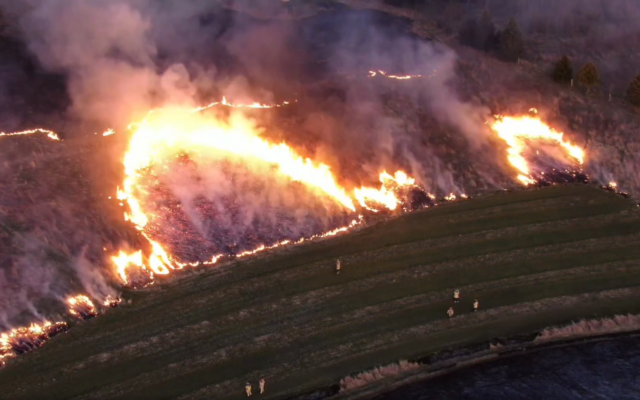Bryan Stevenson on teaching history and the pursuit of justice

▶ Watch Video: Confronting history, to heal a nation
If you’re a movie fan, you may recognize the name Bryan Stevenson as the hero of the 2019 film “Just Mercy,” played by Michael B. Jordan. It’s the true story of a Harvard-trained lawyer who saves an innocent Black man from execution in Alabama.
If you’re a Supreme Court justice, you may remember when Bryan Stevenson convinced you to impose a ban on life sentences for children.
And if you’re a visitor to Montgomery, Alabama, the name Bryan Stevenson is everywhere. His nonprofit, the Equal Justice Initiative, created a memorial to the 4,400 victims of lynchings in America. It’s called the National Memorial for Peace and Justice.
Its pathway leads you around a big square, angling steadily downward, underneath more than 800 corten steel monuments to the victims of lynchings. “Each of these monuments represents a county where lynchings took place,” Stevenson said.
Correspondent David Pogue said, “They start out looking like tombstones or coffins, and by the time we’re here, they’re like hanging bodies.”
Stevenson grew up in the poor, rural South, the great-grandson of an enslaved man. He attended Eastern University on scholarship, and wound up at Harvard Law School. But an internship in Georgia changed his life:
“That was the first time I met a condemned prisoner,” he said. “It’s when I learned there that were people in this country who were literally dying for legal assistance.”
“But you were a Harvard Law graduate,” said Pogue. “Did nobody say to you, ‘Dude, you could make a lot more money going to a law firm’?”
“It seemed like everybody said to me, ‘You should be making a lot more money’!” Stevenson laughed. “But I don’t know that I would be passionate. I saw this community and I think I just knew that I’d be engaged.”
In his 2014 memoir, “Just Mercy,” Stevenson describes meeting with the condemned man – and the reaction he faced from trying to help those unjustly convicted. “I got all kinds of death threats, and there were bomb threats,” he said. “People made it really clear that they did not value what I was doing, what we were trying to do.”
Pogue asked, “Why would anyone care?”
“I think it’s because the more you disrupt systems that have operated unfairly for a long time, the more you implicate bigger issues,” Stevenson replied.
Those bigger issues are obvious in his latest achievement: The Legacy Museum, a 40,000-square-foot museum that traces the entire history of American racism.
It begins with the abduction of Africans (“12 million Africans kidnapped, abducted across that ocean; nearly two million didn’t survive the journey”), and the story of slavery.
In one exhibit, an enslaved woman “speaks”: “I wish I could hold those children. I want to let them know that God will take care of them.”
Pogue asked, “These aren’t playwright’s words?”
“No,” Stevenson said. “There are hundreds of what they call slave narratives that we went through.”
The museum also depicts what arose after slavery was outlawed in 1865: a culture of degradation and violence toward Black people. One room contains jars of soil, with a name, place and date.
“Each one represents a lynching that took place in America, where community members have gone to the lynching site and dug soil from that site,” said Stevenson, who noted, “You know, we’ve just had the 20th anniversary of 9/11. I listened all day to the coverage, it was powerful. We believe in memorialization in this country.”
“But that’s different,” said Pogue. “It’s easier for Americans to memorialize something that was done to us, than it is to memorialize something we did to others.”
“Yes, and that’s the irony! This country enslaved Black people for two-and-a-half centuries. We tortured and terrorized black people for a century. We segregated and subjected Black people to racial hierarchy. We continue to imprison and incarcerate and punish people of color in ways that are not proportionate.
“But we can be more than a country of enslavers and lynchers and segregators and executioners,” he said. “But only if we acknowledge that.”
And that, he says, is the point of all of this: To confront our unpleasant history as a first step in healing.
Of course, not everyone is delighted.
Pogue asked, “You might have heard this term ‘critical race theory’?”
Stevenson laughed. “I have!”
“At this moment, people are saying, ‘People like you are trying to make us feel ashamed of America.'”
“Yes, you’re right – some people are like, ‘Well, I’m afraid to deal with the truth because I don’t know what I’ll feel.’ I don’t want to punish America for this history; I want to liberate us. I want us to get to something better. But to get there, we’re going have to talk more honestly about the barriers we constructed over 400 years.”
What’s striking about Stevenson’s offices, memorial and museum is that they all sit on the very streets where Black people once arrived in chains. “It doesn’t make the city leaders uncomfortable that you’re pushing everybody’s faces in the shame of this place’s ugly history?” asked Pogue.
“I think it’s really important that we tell these stories in ways that are authentic and represent the power of place,” Stevenson said. “A lot of people have said, ‘Oh, your national memorial is really powerful; you just should have put that in Washington.’ I want people to come to Montgomery.”
Pogue asked, “In your book, you describe yourself as ‘broken.’ Is this work against this resistant system what made you feel broken?”
“I mean, I’ve had to stand next to people before they were pulled away, strapped in an electric chair, and burned to death. And so, it’s hard. I am broken, but I believe in brokenness. I’ve come to identify with the plight of those who are suffering.”
Since the case described in the movie, Stevenson has helped to save 145 wrongly-convicted prisoners from execution. But he will tell you his work is far from finished.
Pogue said, “From the outside, it seems like your work generally falls into two categories: There’s all this, which is education about the past, lynchings and slavery; and then there’s your real job, which is representing people who’ve been unfairly incarcerated. Is there a connection between slavery then and incarceration now?”
“Oh, absolutely,” Stevenson replied. “I mean, we have the most punitive society on the planet. We tolerate excessive punishment that very few societies tolerate. And that’s largely because we have been acculturated to accept extreme punishment, beginning with enslavement, beginning with lethal violence and lynchings. History will help us recognize that this stuff is connected. It’s all connected.
“You know, for me it’s all one job, and the job is justice.”
For more info:
- “Just Mercy: A Story of Justice and Redemption” by Bryan Stevenson (One World), in Trade Paperback, eBook and Audio formats, available via Amazon and Indiebound
- Equal Justice Initiative
- Legacy Museum, Montgomery, Ala.
- National Memorial for Peace and Justice, Montgomery, Ala.
Story produced by Mark Hudspeth. Editor: Joseph Frandino.



